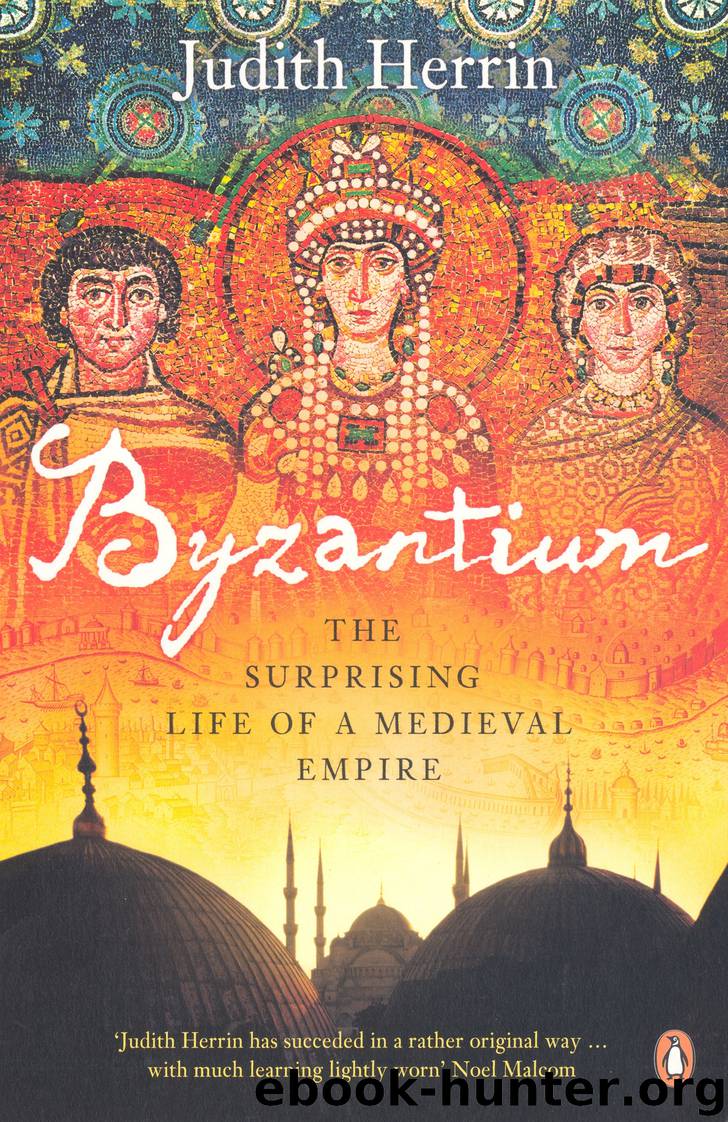Byzantium by Judith Herrin

Author:Judith Herrin
Language: eng
Format: epub
Publisher: Penguin Publishing
Published: 2007-01-01T05:00:00+00:00
17
Imperial Children, ‘Born in the Purple’
In 1044, the Byzantines protested against Constantine IX’s mistress, Maria Skleraina, and demanded to see the real empresses. ‘We don’t want the Skleraina as empress. We don’t want her to cause the death of our mothers, the porphyrogennetoi Zoe and Theodora.’
John Skylitzes, Chronicle, eleventh century
The adjective ‘born in the purple’ (Greek, porphyrogennetos) derives from the porphyra, a special room lined with porphyry, purple stone, or hung with purple silk, which was constructed within the Great Palace before 750. In that year Irene, the Khazar princess who became Constantine V’s first wife, gave birth to a male child, named Leo after his grandfather. He was later identified both as ‘the Khazar’ and porphyrogennetos; he was the first imperial child born in the Purple Chamber. This special complex was an initiative of the iconoclast emperor, who also built the church of the Virgin of the Pharos (Lighthouse) within the palace complex. It became the room in which empresses delivered their children, who all bore the epithet ‘born in the purple’. This was a creative device, which introduced a new title as a way of ensuring dynastic imperial authority.
In Roman times, birth ‘in purple’ was a term commonly used of imperial children, who might even be wrapped in purple-edged swaddling clothes. The expensive dye, derived from tiny murex shellfish, was employed to enhance imperial dignity. As we have seen, Byzantine emperors and their families monopolized the wearing of purple silks and they sent diplomatic gifts of purple cloth, which were particularly appreciated abroad. A sarcophagus made of porphyry, the purple stone mined only from a source in Egypt, was also reserved for rulers.
Whether or not the porphyra was intended to guarantee the legitimacy of the porphyrogennetoi, Constantine V understood the important role it could play in consolidating dynastic rule in Byzantium. His wife Irene, a child bride brought to Constantinople to strengthen a political alliance, does not appear to have had any children until the birth of Leo. The happy event was celebrated and Leo was crowned co-emperor one year later. In these two measures, the construction of the porphyra and the coronation of his first-born son, we can sense Constantine’s determination to secure the continuity of his dynasty. Although he later had many other sons by his third wife and raised them to high-ranking positions, he always regarded Leo as his heir.
By emphasizing a truly imperial birth marked by a new qualification ‘born in the purple’, Constantine wished to make the office of emperor hereditary. In a departure from the Roman principle of election, in which the Senate and army both played a major part, he tried to impose the principle of dynastic inheritance from father to son. The Purple Chamber, which contributed to this new medieval method of designating the heir apparent, also sidelined the senatorial aristocracy and the generals. Other rulers such as Herakleios had already insisted on maintaining their own families in power, and for those with no sons, ways of adopting a successor were well known.
Download
This site does not store any files on its server. We only index and link to content provided by other sites. Please contact the content providers to delete copyright contents if any and email us, we'll remove relevant links or contents immediately.
| Africa | Americas |
| Arctic & Antarctica | Asia |
| Australia & Oceania | Europe |
| Middle East | Russia |
| United States | World |
| Ancient Civilizations | Military |
| Historical Study & Educational Resources |
Room 212 by Kate Stewart(4741)
The Crown by Robert Lacey(4574)
Endurance: Shackleton's Incredible Voyage by Alfred Lansing(4508)
The Iron Duke by The Iron Duke(4124)
The Rape of Nanking by Iris Chang(4024)
Killing England by Bill O'Reilly(3899)
Joan of Arc by Mary Gordon(3786)
Say Nothing by Patrick Radden Keefe(3726)
I'll Give You the Sun by Jandy Nelson(3274)
Shadow of Night by Deborah Harkness(3177)
Hitler's Monsters by Eric Kurlander(3165)
Mary, Queen of Scots, and the Murder of Lord Darnley by Alison Weir(3069)
Blood and Sand by Alex Von Tunzelmann(3060)
Darkest Hour by Anthony McCarten(3019)
Margaret Thatcher: The Autobiography by Thatcher Margaret(2972)
Eleanor & Park by Rainbow Rowell(2944)
Red Famine: Stalin's War on Ukraine by Anne Applebaum(2816)
Book of Life by Deborah Harkness(2721)
The One Memory of Flora Banks by Emily Barr(2686)
